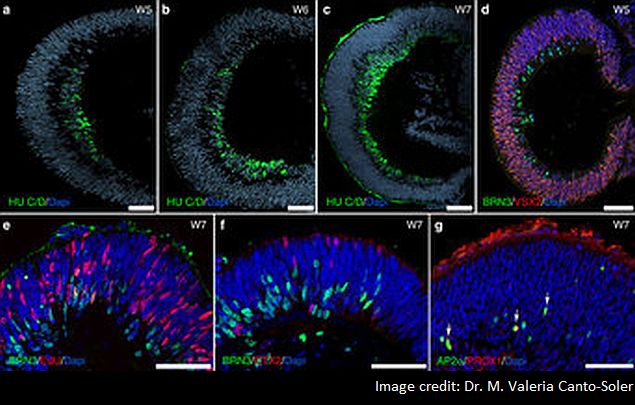- Home
- Science
- Science News
- Researchers Create Functional Retinal Tissue With Stem Cells
Researchers Create Functional Retinal Tissue With Stem Cells

"We have basically created a miniature human retina in a dish that not only has the architectural organisation of the retina but also has the ability to sense light," claimed M. Valeria Canto-Soler, an assistant professor at Johns Hopkins University's school of medicine.
The retinal tissue created in the laboratory - using human induced pluripotent stem cells (iPS) - includes functioning photoreceptor cells capable of responding to light, the first step in the process of converting it into visual images.
"The work advances opportunities for vision-saving research and may ultimately lead to technologies that restore vision in people with retinal diseases," she noted.
Using a simple, straightforward technique they developed to foster the growth of the retinal progenitors, the researchers saw retinal cells and then tissues growing in petri dishes.
The growth corresponded in timing and duration to retinal development in a human foetus in the womb.
Moreover, the photoreceptors were mature enough to develop outer segments - a structure essential for photoreceptors to function.
However, Canto-Soler cautioned that photoreceptors are only part of the story in the complex eye-brain process of vision, and her lab has not yet recreated all of the functions of the human eye and its links to the visual cortex of the brain.
The achievement could eventually enable genetically engineered retinal cell transplants that halt or even reverse a patient's march toward blindness.
The findings appeared in the journal Nature Communications.
Catch the latest from the Consumer Electronics Show on Gadgets 360, at our CES 2026 hub.
- Samsung Galaxy Unpacked 2025
- ChatGPT
- Redmi Note 14 Pro+
- iPhone 16
- Apple Vision Pro
- Oneplus 12
- OnePlus Nord CE 3 Lite 5G
- iPhone 13
- Xiaomi 14 Pro
- Oppo Find N3
- Tecno Spark Go (2023)
- Realme V30
- Best Phones Under 25000
- Samsung Galaxy S24 Series
- Cryptocurrency
- iQoo 12
- Samsung Galaxy S24 Ultra
- Giottus
- Samsung Galaxy Z Flip 5
- Apple 'Scary Fast'
- Housefull 5
- GoPro Hero 12 Black Review
- Invincible Season 2
- JioGlass
- HD Ready TV
- Laptop Under 50000
- Smartwatch Under 10000
- Latest Mobile Phones
- Compare Phones
- OPPO Reno 15 Pro Max
- Honor Win RT
- Honor Win
- Xiaomi 17 Ultra Leica Edition
- Xiaomi 17 Ultra
- Huawei Nova 15
- Huawei Nova 15 Pro
- Huawei Nova 15 Ultra
- Asus ProArt P16
- MacBook Pro 14-inch (M5, 2025)
- OPPO Pad Air 5
- Huawei MatePad 11.5 (2026)
- Xiaomi Watch 5
- Huawei Watch 10th Anniversary Edition
- Acerpure Nitro Z Series 100-inch QLED TV
- Samsung 43 Inch LED Ultra HD (4K) Smart TV (UA43UE81AFULXL)
- Asus ROG Ally
- Nintendo Switch Lite
- Haier 1.6 Ton 5 Star Inverter Split AC (HSU19G-MZAID5BN-INV)
- Haier 1.6 Ton 5 Star Inverter Split AC (HSU19G-MZAIM5BN-INV)












